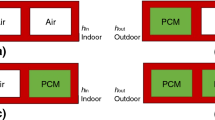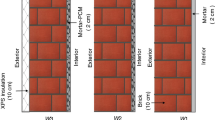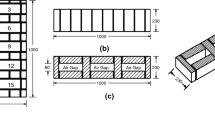Abstract
The building sector in Morocco represents 25% of the country’s total energy consumption. The poor thermal performance of the building envelopes is one of the principal reasons for this consumption rate. In this study, the efficiency of integrating Phase Change Materials (PCM) into hollow bricks used in three typical housing types in the six climate zones in Morocco is investigated. The numerical model is based on the heat transfer equation and the apparent heat capacity formulation to model the phase change. A heat flux analysis is performed at the internal surface of the wall, giving a good understanding of the thermal behavior of hollow bricks with PCMs compared with hollow bricks with air. The results show that the heat flux density at the internal face of the wall is constant when the PCM is partially solid/liquid, and follows the outdoor conditions when the PCM is fully solid or fully liquid. Irrespective of the climate zone, the PCM with a 32 °C median melting temperature reduces the heat flux peak value in the hotel housing while the PCM with a 37 °C median melting temperature is better for the individual and collective housing. On the other hand, the PCM with a 27 °C median melting temperature is able to save up to 25% and 40% of energy consumption in the Saharan climate and oceanic climate, respectively.
Similar content being viewed by others
References
Abhat A (1983). Low temperature latent heat thermal energy storage: Heat storage materials. Solar Energy, 30: 313–332.
Aderee (2011a). Règelement thermique de construction au Maroc. (in French)
Aderee (2011b). Zonage climatique du maroc destine a la reglementation de thermique du batiment. (in French)
Alawadhi EM, Alqallaf HJ (2011). Building roof with conical holes containing PCM to reduce the cooling load: Numerical study. Energy Conversion and Management, 52: 2958–2964.
Alqallaf HJ, Alawadhi EM (2013). Concrete roof with cylindrical holes containing PCM to reduce the heat gain. Energy and Buildings, 61: 73–80.
Álvarez S, Cabeza LF, Ruiz-Pardo A, Castell A, Tenorio JA (2013). Building integration of PCM for natural cooling of buildings. Applied Energy, 109: 514–522.
Ansuini R, Larghetti R, Giretti A, Lemma M (2011). Radiant floors integrated with PCM for indoor temperature control. Energy and Buildings, 43: 3019–3026.
Ascione F, Bianco N, De Masi RF, de’ Rossi F, Vanoli GP (2014). Energy refurbishment of existing buildings through the use of phase change materials: Energy savings and indoor comfort in the cooling season. Applied Energy, 113: 990–1007.
Berardi U, Soudian S (2018). Benefits of latent thermal energy storage in the retrofit of Canadian high-rise residential buildings. Building Simulation, 11: 709–723.
Brenner SC, Scott LR (2008). The Mathematical Theory of Finite Element Methods, 3rd edn. New York: Springer.
Burkhard BJ, Kadakia R (2010). Energy Efficiency in Buildings. World Business Council for Sustainable Development.
Cabeza LF, Castellón C, Nogués M, Medrano M, Leppers R, Zubillaga O (2007). Use of microencapsulated PCM in concrete walls for energy savings. Energy and Buildings, 39: 113–119.
Castellón C, Castell A, Medrano M, Martorell I, Cabeza LF (2009). Experimental study of PCM inclusion in different building envelopes. Journal of Solar Energy Engineering, 131(4): 041006.
Chuah TG, Rozanna D, Salmiah A, Thomas Choong SY, Sa’ari M (2006). Fatty acids used as phase change materials (PCMs) for thermal energy storage in building material applications. Jurutera, 2006(July): 8–15.
Comsol (2015). Heat Transfer Module.
David D, Kuznik F, Roux J-J (2011). Numerical study of the influence of the convective heat transfer on the dynamical behaviour of a phase change material wall. Applied Thermal Engineering, 31: 3117–3124.
Evola G, Marletta L, Sicurella F (2014). Simulation of a ventilated cavity to enhance the effectiveness of PCM wallboards for summer thermal comfort in buildings. Energy and Buildings, 70: 480–489.
Hasse C, Grenet M, Bontemps A, Dendievel R, Sallée H (2011). Realization, test and modelling of honeycomb wallboards containing a Phase Change Material. Energy and Buildings, 43: 232–238.
IEA (2013). Transition to Sustainable Buildings: Strategies and Opportunities to 2050. International Energy Agency.
ISO (1996). ISO 6946. Building Components and Building Elements—Thermal Resistance and Thermal Transmittance—Calculation Method. International Organization for Standardization.
Joulin A, Zalewski L, Lassue S, Naji H (2014). Experimental investigation of thermal characteristics of a mortar with or without a microencapsulated phase change material. Applied Thermal Engineering, 66: 171–180.
Karaeusel J, Wanner B, Kesicki F (2010). World Energy Outlook 2010. Executive Summary. International Energy Agency. pp. 431–442.
Kuznik F, Johannes K, David D (2015). Integrating phase change materials (PCMs) in thermal energy storage systems for buildings. In: Cabeza LF (ed), Advances in Thermal Energy Storage Systems. Oxford, UK: Woodhead Publishing.
Mandilaras I, Stamatiadou M, Katsourinis D, Zannis G, Founti M (2013). Experimental thermal characterization of a Mediterranean residential building with PCM gypsum board walls. Building and Environment, 61: 93–103.
Memon SA (2014). Phase change materials integrated in building walls: A state of the art review. Renewable and Sustainable Energy Reviews, 31: 870–906.
Royon L, Karim L, Bontemps A (2014). Optimization of PCM embedded in a floor panel developed for thermal management of the lightweight envelope of buildings. Energy and Buildings, 82: 385–390.
Sharifi NP, Freeman GE, Sakulich AR (2015). Using COMSOL modeling to investigate the efficiency of PCMs at modifying temperature changes in cementitious materials—Case study. Construction and Building Materials, 101: 965–974.
Sharifi NP, Shaikh AAN, Sakulich AR (2017). Application of phase change materials in gypsum boards to meet building energy conservation goals. Energy and Buildings, 138: 455–467.
Shilei L, Guohui F, Neng Z, Li D (2007) Experimental study and evaluation of latent heat storage in phase change materials wallboards. Energy and Buildings, 39: 1088–1091.
Thiele AM, Sant G, Pilon L (2015). Diurnal thermal analysis of microencapsulated PCM-concrete composite walls. Energy Conversion and Management, 93: 215–227.
Yu J, Yang C, Tian L (2008). Low-energy envelope design of residential building in hot summer and cold winter zone in China. Energy and Buildings, 40: 1536–1546.
Zhang YP, Lin KP, Yang R, Di HF, Jiang Y (2006). Preparation, thermal performance and application of shape-stabilized PCM in energy efficient buildings. Energy and Buildings, 38: 1262–1269.
Zhou G, Zhang Y, Lin K, Xiao W (2008). Thermal analysis of a direct-gain room with shape-stabilized PCM plates. Renewable Energy, 33: 1228–1236.
Zhou D, Shire GSF, Tian Y (2014). Parametric analysis of influencing factors in Phase Change Material Wallboard (PCMW). Applied Energy, 119: 33–42.
Acknowledgements
The authors would like to thank Pr. Elena Palomo Del Barrio for useful and valuable discussions while carrying out the present work. The authors are grateful to the MIC program Erasmus+ 2016–2018 for the Ph.D. scholarship to Z. Aketouane.
Author information
Authors and Affiliations
Corresponding author
Electronic supplementary material
Rights and permissions
About this article
Cite this article
Aketouane, Z., Malha, M., Bruneau, D. et al. Energy savings potential by integrating Phase Change Material into hollow bricks: The case of Moroccan buildings. Build. Simul. 11, 1109–1122 (2018). https://doi.org/10.1007/s12273-018-0457-5
Received:
Revised:
Accepted:
Published:
Issue Date:
DOI: https://doi.org/10.1007/s12273-018-0457-5




